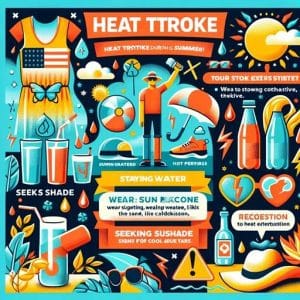Staying Cool and Healthy in the Heat: A Family Guide
As the planet warms, understanding how to stay safe in hot weather is more important than ever. Heat-related illnesses, from mild cramps to severe heatstroke, can affect anyone, but with the right knowledge and precautions, most can be prevented. Let’s dive into the essentials of staying cool and safeguarding your family’s health during the hot months.
What Causes Heat-Related Illnesses?
Our bodies usually manage heat by sweating and letting heat escape through the skin. However, during intense heat waves, high humidity, or vigorous physical activity, this cooling system might struggle, leading to heat illnesses like cramps, exhaustion, or even heatstroke.
Understanding Heat Cramps
Heat cramps are the body’s initial signal of heat distress, manifesting as painful muscle spasms, often in the legs, arms, or abdomen. They occur during or after intense physical activity in high temperatures when the body loses fluids and salts through excessive sweating. Children, especially those not consuming enough fluids, are particularly susceptible.
Preventing and Treating Heat Cramps:
- Move to a cool place and rest.
- Drink water or electrolyte-rich sports drinks.
- Gently stretch and massage the affected muscles.
- Take it easy for a few hours after the cramps subside.
If cramps persist or if the individual has specific health conditions, seek medical attention.

Heat Exhaustion: A Serious Warning
Heat exhaustion is a significant heat illness that happens when someone hasn’t drunk enough fluids in hot conditions. Symptoms can include thirst, weakness, dizziness, nausea, and more. Without proper intervention, it can escalate to heatstroke.
Responding to Heat Exhaustion:
- Find a cooler, preferably air-conditioned, place.
- Remove excess clothing to help cool down.
- Encourage drinking water or sports drinks.
- Apply cool, wet cloths to the skin.
Contact your healthcare provider if symptoms persist or if the person is unable to hydrate properly.
The Dangers of Heatstroke
Heatstroke is a critical emergency where the body loses its ability to regulate temperature, leading to potentially fatal temperatures above 104°F (40°C). It requires immediate medical attention.
Heatstroke Symptoms and First Aid:
- Call emergency services if you notice symptoms like confusion, rapid breathing, flushed skin, or a high fever.
- Move the person to a cooler place.
- Cool them down with wet cloths or a bath, but avoid giving fluids if they’re not fully conscious.
Preventing Heat Illnesses: Key Strategies
Prevention is the best defense against heat-related illnesses. Here are some strategies to keep your family safe:
- Hydrate: Drink plenty of fluids before, during, and after outdoor activities.
- Dress Smart: Wear light-colored, loose clothing and sunscreen.
- Plan Activities Wisely: Schedule outdoor activities during cooler parts of the day.
- Listen to Your Body: Move indoors and rest immediately if feeling overheated.
By following these guidelines and teaching them to your children, you can enjoy the warm weather safely and healthily. Awareness and proactive measures are crucial in preventing heat illnesses, ensuring your family’s well-being during the summer and beyond. You can book appointment on call visit clinic or online video consultations with a best child specialist in in Lahore.
